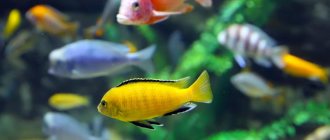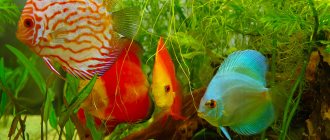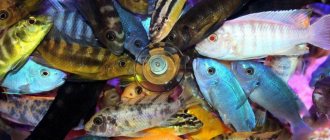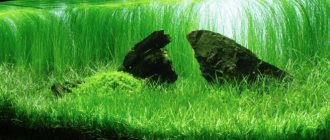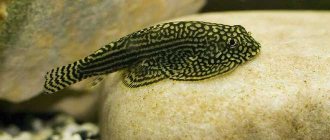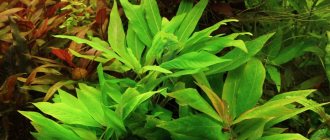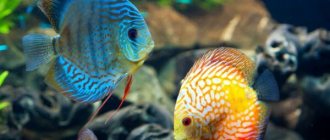American cichlids are distinguished by their size and very quarrelsome disposition. There are exceptions, but they only confirm the rules. Large, aggressive, loving to dig up soil, they are also very beautiful and intelligent. Of course, American cichlids are not suitable for every hobbyist, and especially not for beginners. More precisely, there is nothing extra complicated about keeping them in an aquarium, they are just not for general aquariums. And they are sold to beginners as completely harmless fish. So that your expectations are not disappointed, read carefully about the fish described above. Separately, I would like to note that American cichlids are prone to interspecific crossing, and sometimes produce excellent offspring. For example, Flower Horn and Red Parrot have gained well-deserved popularity among cichlid lovers. We even included them in a separate chapter dedicated to hybrids.
Origin
Cichlids are not only aquarium fish, some of them are commercial objects. They live in rivers and lakes of tropical South and Central America, in the waters of Africa and Asia. There are a lot of cichlids, some species are not even described, while others are on the verge of extinction.
African and American cichlids are most often kept in aquariums.
American cichlids include:
- Astronotuses
- Akary
- Cichlazomas
- Angelfish
- Discus
- Apistograms
Feeding rules
Bright beauties are classified as predators with a mixed menu. Tropical guests eat almost all types of frozen and live food presented in pet stores. Fresh seafood and squid are allowed as food. The meat of warm-blooded animals is poorly digestible, so adding it to the diet is undesirable. Vegetables allowed in limited quantities:
Prone to mild obesity
Cichlids are prone to gluttony, which forces the owner to control the amount of food eaten and the frequency of feeding. It is recommended for adult specimens to have fasting days once a month. Cunning pets adapt to the owner’s character and learn to beg for food. Obesity is a common cause of death in livestock, so there is no need to succumb to provocations.
Kinds
The golden age of aquarium breeding of cichlids began more than a hundred years ago, back in 1908, when for the first time it was possible to breed several representatives of this species of fish in an aquarium. It is noteworthy that they all came from South America. Subsequently, a huge number of cichlids hit the market, which is not surprising, because these fish have poi
stina of amazing beauty. At the moment, more than 50 genera of American cichlids have been found and described, which belong to two territorial groups:
- South American;
- Central American.
In addition, they are divided by size:
- large;
- dwarf.
Breeding
Breeding cichlids is not a difficult task. There are cases of spontaneous spawning if conditions in the aquarium are favorable. Sexual maturity in fish occurs at the age of 8 to 18 months.
In most species, males are distinguished by a brighter color and a slender, large physique; sometimes the differences are visible in the shape of the fins.
To provoke spawning, it is necessary to raise the temperature of the water in the aquarium, replace some of it with fresher water and add enough protein food to the fish’s diet.
Pisces of this family are good parents. They protect eggs and young animals and take care of them. Types of spawning vary depending on the type of fish: spawning in open areas, in shelters, carrying fry in the mouth, and others.
Keeping in an aquarium
American cichlids are not too whimsical. They can adapt to different environments. But when breeding, they need water whose composition is the same as in their natural habitat. Therefore, it is important to know that American cichlids live in several types of water:
- Brown water loaded with minerals from decaying plants.
- Muddy water due to erosion of the banks by strong currents.
- Clear water found in river beds made of quartz sand.
Therefore, if you need to breed these fish, it is advisable to avoid chemicals that tap water is saturated with, such as chlorine, nitrites, and phosphates. Their concentration is often higher than normal and fish may not survive in such an environment. The water should be as saturated with oxygen as possible.
In addition, it is important to choose the appropriate temperature regime. All cichlids are very sensitive to sudden changes in water temperature. American cichlids are thermophilic. So, before spending money on these fish, you need to create the necessary conditions for them, otherwise it will only be a pointless waste of money.
You also need to remember about preventive cleaning of the aquarium. There is no need to do this too often, since the fish prefer an established biological environment, but occasionally it is necessary to refresh it.
It is advisable to keep American cichlids in large aquariums, especially such as Managuan cichlids and astronotuses. You need to decorate their habitat so that they feel like they are in their natural environment. You can decorate the aquarium with green thickets of Echinodyrus and Cryptocoryne.
Cichlids of South America
They inhabit the vast basin of the Amazon River and some other river systems of the tropical and equatorial belts flowing into the Atlantic Ocean. They inhabit small streams and channels flowing under the canopy of the rain forest. The typical habitat is shallow ponds with a slow current, littered with fallen vegetation (leaves, fruits), tree branches, and snags. Due to the decomposition of organic matter and the release of tannins, the water acquires a characteristic “tea” color.
Content
Keeping aquariums is quite simple, with the exception of some demanding species, such as Discus fish. They prefer soft, slightly acidic water, dim lighting levels, soft substrates and an abundance of aquatic plants.
Most South American cichlids are considered peaceful and calm species, able to get along with many other freshwater species. Tetras, which naturally occur in the same habitat, will be excellent neighbors in the aquarium. South American cichlids are caring parents, so during the spawning period and during the subsequent care of the offspring, they become quite aggressive, but if the aquarium is large enough, then there will be no problems.
Chromis butterfly
Ramirez's Chromis butterfly, scientific name Mikrogeophagus ramirezi, belongs to the family Cichlidae
Angelfish High-bodied
High-bodied Angelfish or Big Angelfish, scientific name Pterophyllum altum, belongs to the family Cichlidae
Angelfish
Angelfish, scientific name Pterophyllum scalare, belongs to the family Cichlidae
Oscar
Oscar or water buffalo, astronotus, scientific name Astronotus ocellatus, belongs to the family Cichlidae
Severum Efasciatus
Cichlid Severum Efasciatus, scientific name Heros efasciatus, belongs to the family Cichlidae
Handsome Chromis
Chromis beauty, scientific name Hemichromis bimaculatus, belongs to the family Cichlidae
Severum Notatus
Cichlid Severum notatus, scientific name Heros notatus, belongs to the family Cichlidae
Akara blue
Acara blue or Acara blue, scientific name Andinoacara pulcher, belongs to the family Cichlidae
Akara Maroni
Acara Maroni or Keyhole Cichlid, scientific name Cleithracara maronii, belongs to the family Cichlidae
Turquoise Akara
Turquoise Acara, scientific name Andinoacara rivulatus, belongs to the family Cichlidae
Pearl cichlid
Pearl cichlid or Brazilian Geophagus, scientific name Geophagus brasiliensis, belongs to the family Cichlidae
Chess cichlid
Checkerboard Cichlid, Checkerboard Cichlid or Crenicara Lyretail, scientific name Dicrossus filamentosus, belongs to the family Cichlidae
Yellow-eyed cichlid
Yellow-eyed cichlid or Nannacara green, scientific name Nannacara anomala, belongs to the family Cichlidae
Umbrella Cichlid
Umbrella cichlid or Apistogramma Borellii, scientific name Apistogramma borellii, belongs to the family Cichlidae
McMaster's Apistogram
McMaster's Apistogramma or Red-tailed Dwarf Cichlid, scientific name Apistogramma macmasteri, belongs to the family Cichlidae
Apistogramma of Agassiz
Apistogramma Agassizii or Cichlid Agassiz, scientific name Apistogramma agassizii, belongs to the family Cichlidae
Apistogramma Panda
Nijssen's Apistogramma panda or simply Nijssen's Apistogramma, scientific name Apistogramma nijsseni, belongs to the family Cichlidae
Apistogramma Cockatoo
Apistogramma Cockatoo or Cockatoo Cichlid, scientific name Apistogramma cacatuoides, belongs to the family Cichlidae
Chromis red
Chromis red or Red Stone Cichlid, scientific name Hemichromis lifalili, belongs to the family Cichlidae
Discus
Discus, scientific name Symphysodon aequifasciatus, belongs to the family Cichlidae
Heckel's discus
Heckel's discus, scientific name Symphysodon discus, belongs to the family Cichlidae
Apistogram of Hongslo
Apistogramma Hongsloi, scientific name Apistogramma hongsloi, belongs to the family Cichlidae
Acara curviceps
Acara curviceps, scientific name Laetacara curviceps, belongs to the family Cichlidae
Fire-tailed Apistogramma
The fire-tailed apistogramma, scientific name Apistogramma viejita, belongs to the family Cichlidae
Acara Porto Alegre
Acara Porto Alegre, scientific name Cichlasoma portalegrense, belongs to the family Cichlidae
Cichlasoma mesonauta
Cichlid mesonauta or Festivum, scientific name Mesonauta festivus, belongs to the family Cichlidae
Geophagus demon
Geophagus demon or Satanoperca daemon, scientific name Satanoperca daemon, belongs to the family Cichlidae
Geophagus Steindachner
Geophagus Steindachneri, scientific name Geophagus steindachneri, belongs to the family Cichlidae
Red-breasted Akara
Letacara Dorsigera or Red-breasted Acara, scientific name Laetacara dorsigera, belongs to the family Cichlidae
Threaded Akara
Haeckel's Acarichthys or Threaded Acara, scientific name Acarichthys heckelii, belongs to the family Cichlidae
Geophagus altifrons
Geophagus altifrons, scientific name Geophagus altifrons, belongs to the family Cichlidae
Geophagus Winemiller
Geophagus Winemiller, scientific name Geophagus winemilleri, belongs to the family Cichlidae
Geophaus Yurupara
Jurupari or Geophaus Jurupara, scientific name Satanoperca jurupari, belongs to the family Cichlidae
Bolivian butterfly
Bolivian butterfly or Apistogramma altispinosa, scientific name Mikrogeophagus altispinosus, belongs to the family Cichlidae
Apistogramma Norberti
Apistogramma Norberti, scientific name Apistogramma norberti, belongs to the family Cichlidae
Azure cichlid
Azure Cichlid, Blue Cichlid or Apistogramma Panduro, scientific name Apistogramma panduro, belongs to the family Cichlidae
Apistogramma Hoigne
Apistogramma hoignei, scientific name Apistogramma hoignei, belongs to the family Cichlidae
Apistogramma highfin
High-finned apistogramma, scientific name Apistogramma eunotus, belongs to the family Cichlidae
Two-band Apistogram
Apistogramma biteniata or Double-banded Apistogramma, scientific name Apistogramma bitaeniata, belongs to the family Cichlidae
Akara mesh
Acara reticulata, scientific name Aequidens tetramerus, belongs to the family Cichlidae
Geophagus Orangehead
Geophagus Orangehead, scientific name Geophagus sp. "Orange head", belongs to the family Cichlidae
Geophagus proximus
Geophagus proximus, scientific name Geophagus proximus, belongs to the family Cichlidae (cichlids)
Geophagus pindare
Geophagus pindare, scientific name Geophagus sp. Pindare, belongs to the family Cichlidae
Geophagus Iporanga
Geophagus iporangensis, scientific name Geophagus iporangensis, belongs to the family Cichlidae (Cichlids)
Geophagus Pellegrini
Geophagus Pellegrini or Geophagus yellow-throated, scientific name Geophagus pellegrini, belongs to the family Cichlidae
Kellery's apistogram
Apistogramma Kelleri or Apistogramma Laetitia, scientific name Apistogramma sp. Kelleri, belongs to the family Cichlidae
Steindachner's apistogram
Steindachner's Apistogramma, scientific name Apistogramma steindachneri, belongs to the family Cichlidae (cichlids)
Three-banded apistogram
Apistogramma trifasciata, scientific name Apistogramma trifasciata, belongs to the family Cichlidae
Geophagus Brokopondo
Geophagus Brokopondo, scientific name Geophagus brokopondo, belongs to the family Cichlidae
Geophagus dicrozoster
Geophagus dicrozoster, Geophagus Suriname, Geophagus Colombia scientific name Geophagus dicrozoster, belongs to the family Cichlidae
Cichlid Cupid
Biotodoma cupido or Cupid Cichlid, scientific name Biotodoma cupido, belongs to the family Cichlidae
Sharp-headed Satanfin
The sharp-headed Satanoperca or Heckel's Geophagus, scientific name Satanoperca acuticeps, belongs to the family Cichlidae
Satanoperka lekostikos
Satanoperca leucosticta, scientific name Satanoperca leucosticta, belongs to the family Cichlidae
Spotted Geophagus
Spotted Geophagus, scientific name Geophagus abalios, belongs to the family Cichlidae
Geophagus Neambi
Geophagus Neambi or Geophagus Tocantins, scientific name Geophagus neambi, belongs to the family Cichlidae
Retroculus Xingu
Retroculus xingu, scientific name Retroculus xinguensis, belongs to the family Cichlidae
Geophagus suriname
Geophagus surinamensis, scientific name Geophagus surinamensis, belongs to the family Cichlidae (Cichlids)
Cichlasoma mesonauta
Cichlid mesonauta or Festivum, scientific name Mesonauta festivus, belongs to the family Cichlidae
Compatibility with other fish
Many lovers of beautiful fish, not knowing about the surprises awaiting them, introduce American cichlids into the aquarium with gouramis, swordtails, barbs and other aquarium fish. After some time, you can observe uprooted plants, dug up soil, moved stones, and fish gather in schools and rush around restlessly, some of them may even disappear altogether. And all because cichlids appeared in the aquarium. They are very aggressive and do not like to share territory.
Together they only get along with representatives of their own species, but it is still better to keep cichlids of the same size in the same aquarium. But there are species that cannot get along even with their own and must be kept separately. American cichlids have an obnoxious character, which is especially evident during the breeding season. In large aquariums, they spread out into different corners, which makes keeping them together more or less bearable.
Description
The fish has a powerful body, slightly oval in shape. The frontal part of the large head forms a concave line. In nature it grows up to 30 cm, in captivity its size does not exceed 20 cm.
Appearance
The original coloring is the main pride of the Texas cichlid . The dark brown “dress” of the fish is strewn with sparkling spots of green and blue, creating a diamond effect.
The decor of the outfit does not end there. On the sides there are barely visible transverse dark lines. Along the upper part of the body, from the tail to the head, there is a dotted line of black spots.
The finishing touch is two large black spots, one in the center of the body, the other at the tail.
Among the hybrid species, the brilliant red cichlid (Red Texas) and Flower Horn are especially beautiful.
Nuances of behavior
Cichlazoma diamond short-bodied is in perpetual motion . She actively scours the aquarium, plows up the soil, looks for someone to fight, and quickly crosses the pond from wall to wall.
If she doesn't like some decoration, she will turn it over or break it.
The aggressiveness of the fish is rated at 6–7 points on a ten-point scale.
can fight not only . Eats food with excitement, scattering pieces of food throughout the aquarium.
The owners claim that their pets have high intelligence. The fish quickly get used to the feeding hand and know their owner well.
Lifespan
Diamond cichlises are real long-livers in the aquarium world.
By creating the most comfortable conditions and carefully monitoring the condition of your pets, you can enjoy their life in the aquarium for 15–17 years.
Features of reproduction
Cichlids are excellent parents and raise their offspring selflessly and originally. They are distinguished by very interesting mating games. During this period, their color becomes brighter. Difficulties may arise with breeding. Sometimes pairs of fish may not reproduce for a long time. They may need special feeding and natural living conditions. During the breeding season, it is better to keep them separate from other fish. But before transplanting a pair, you need to make sure that the female is ready to reproduce. Otherwise, the male may kill her.
During breeding, cichlids, when building a nest, can dig up all the soil to find a better place and move heavy stones. Therefore, during the mating season, they can destroy the entire aquarium.
Having laid eggs, cyclids diligently protect them from everyone, even from each other.
Cornflower blue haplochromis: DESCRIPTION, CONTENTS, BREEDING, COMPATIBILITY, PHOTO, VIDEO.
ACARA PERUVIAN: DESCRIPTION, CONTENTS, BREEDING, PHOTO, VIDEO.
AKARA PARAGUAYAN, AKARA VITTATA (BUJURQUINA VITTATA)
Diseases
Fish of this species do not have an innate predisposition to common diseases.
Most problems arise due to poor care and non-compliance with basic parameters.
Let's look at what diseases you can encounter when keeping cichlases.
Ascites (dropsy)
The disease is caused by dirty water. A sick individual refuses food, is afraid of light and moves little.
The problem is aggravated by bulging eyes. Baths with antibiotics are used as a remedy.
Ichthyophthiriasis (“semolina”)
Prolonged exposure to water with a low temperature leads to the appearance of white grains on the body of fish.
To prevent a negative reaction, it is necessary to urgently increase the temperature to a normal value and increase aeration so that the water column quickly warms up.
Dactylogyrosis
Infectious diseases. Parasites penetrate into a body of water with dirty soil or poor quality food .
A sick fish stops eating, gasps for air, and mucus appears on the gills. Adding copper sulfate to the water (0.15 g per 100 liters) helps rid the individual of the parasite.
Lepidorthosis
The main symptom of the disease is scale loss. For treatment, baths are made with streptocide (0.30 g per 20 liters) or biomycin (0.15 g per 10 liters).
Plistophorosis
The infection can be transmitted by already sick fish. Sick individuals lose color , develop large light spots, eat poorly and lose weight.
The use of Nemazol or Fumagelin helps get rid of the infection.
Obesity
Significant weight gain is caused by overfeeding, the use of fatty meat, and monotony of food.
The fish are given fasting days and their diet is balanced.
Mr. Tail Recommends: Cichlid Aquarium Basics
Even if only cichlids are stocked in the aquarium, it is very interesting to observe their behavior. These fish amaze not only with the beauty of their coloring, but also with their active social life, high intelligence and touching care for their offspring.
The most common cichlids kept in home aquariums are angelfish, discus, melanochromus, oscar, chromis, and cichlas. Among these species there are individuals that differ significantly in size, shape of the body and fins, and type of nutrition - these are omnivores and predators.
But the general requirements for keeping cichlids are the same:
- They need spacious tanks with a capacity of at least 60 liters, and preferably 300-400 liters.
- It is necessary to provide for the organization of grottoes, caves, driftwood, which will have not only a decorative, but also a protective function.
- It is better to house cichlids in pairs or small families, where there are 2-3 females per male.
- Optimum temperature +27…+28 °C.
- Regular changes of a third of the water should be done at least 2 times a week.
- It is mandatory to install powerful, preferably remote, filters and an aeration system.
- It is better to install a special lid with an artificial lighting system on the tank.
Experienced aquarists believe that the best cichlid is a bare stone wasteland, and it is better to install artificial plants, since live ones will be eaten instantly.
But for some species of cichlids, such as apistogramma and parakeets, you can organize a real underwater garden. Only in this case is it important to correctly zone the reservoir, creating areas of grottoes and thickets there, as well as free space for the active movement of individuals.
Zoning is very important for group keeping, for example, angelfish, since each pair occupies its own territory, which it actively protects.
Vallisneria, which, when growing, creates a kind of screen-thickets, is well suited as a plant for these species of cichlids.
For Malawian cichlid species, it is a good idea to float duckweed on the surface of the water as natural feeding. Decorative grottoes, coconut halves, driftwood, pots and amphorae also help with zoning. The soil is not so important; cichlids are indifferent to it. Lighting in an artificial tank should be moderate, in cool colors.
Diseases: external signs and treatment
American and Asian cichlids get sick quite rarely. African fish sometimes suffer from bloating. Symptoms of the disease:
- appetite suppression;
- the desire to take refuge in a shelter, lie on the bottom, hover on the surface of the water;
- lethargy;
- whitish thread-like stool;
- redness in the anal area;
- swollen abdomen (indicates a fatal stage of the disease; the fish cannot be saved).
Golden cichlid
Treatment is carried out according to the following scheme:
- Place the sick fish in a separate container , increase aeration, turn off filters and sterilization.
- Dissolve bitter Epsom salt metronidazole (sold in pharmacies as a laxative) in water in a ratio of 2-3 tablespoons per 45 liters of water.
- Twice a day, the water in the “infirmary” is replaced by half the volume and the drug is added again.
- The course of treatment is 4-5 days , if the fish has not recovered, but has not died, take a break for 2-3 days and repeat the procedure.
